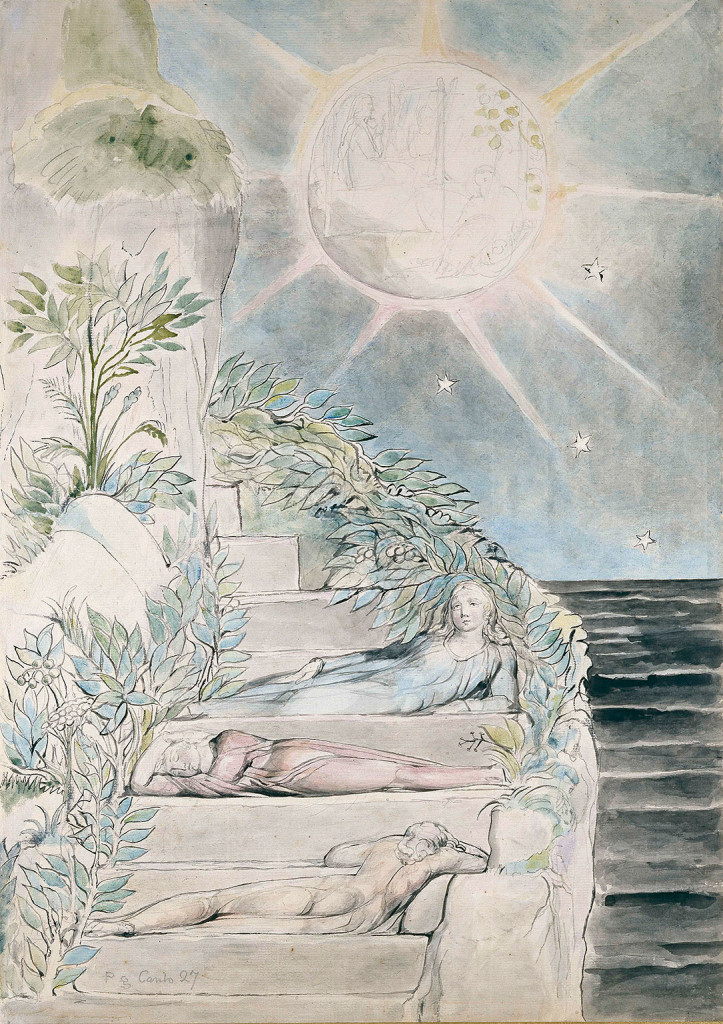
Dante and Statius Sleeping, Virgil Watching by William Blake
Watercolor with some pen and black ink over indications in graphite
1825-1827
(H: 52 × W: 36.8 cm)
The restfulness of the scene, the presence of the moon, and the location of the steps, above the errors of the material world but below Eden, all tell us that Blake as set this illustration in the land that he calls Beulah.
. . . .
Beulah exists between the material world, below, and Eternity, above. Because the souls in Eternity engage in endless mental fight, a space of rest is essential, and souls may descend to sleep in Beulah at will. Blake depict souls in Eternity as male, but on descent to Beulah they divide into make and female, because of the sensual enjoyment and comfort that this brings. This is nota division like that which occurs to the should when it enters the material world, however. Souls my reascend from Beulah to Eternity at any time, and in so doing recombine their emanations. The divisions of Beulah—the word comes from the word in Isaiah beaning “married”—are not so great that conflict occurs; Beulah is a land “Where no dispute can come” (E 197).
In canto 27, Dante describes a dream the pilgrim has while asleep on the stairs. In it, Leah and Rachel, Jacob’s two wives in the Book of Genesis, represent the active and the contemplative lives: Leah weaving a garland and Rachel gazing into a mirror. Blake has cleverly depicted the content of the dream on the surface of the moon, penciled lightly but visibly. Rachel is at right, seated beneath leaves, and leah is at the left. Blake shows Leah seated at a full upright loom, another clear indication that this scene represents the land of Beulah. Her weaving appears as both a depiction of her activity in the dream and a symbol of the main activity of the Daughters of Beulah, who show mercy on those who fall in to the material world by weaving bodies for them. We have seen them before, just before the pilgrim passed between the giants to enter the lower world.
Though a step lower than the highest world, Beulah is open to Eternity. After a night’s rest from the exertions of the climb, the pilgrim is ready to enter the Garden of Eden at the top of the mountain. Dante’s Eden, of course, is the Earthly Paradise, the garden where Adam and Eve began life. Because no one with sin may live there, it is now accessible only to people who have completed the purification process on the mountain. From there, the souls launch themselves upward to Heaven. (From Eric Pyle, William Blake’s Illustrations for Dante’s Divine Comedy: A Study of the Engravings, Pencil Sketches and Watercolors (Jefferson, North Carolina: McFarland & Company, 2015).
Ashmolean Museum, Oxford
Reading
Dante, Purgatorio, cantos 17-33
Topic of Discussion
We will continue with our consideration of MacAllister’s “principle of interaction between the classical and the Christian worlds,” which we began in colloquium 30. For our discussion be prepared to identify three more examples from cantos 17-33 with specific references to the Greek, Roman, and Christian texts. Be sure to have the texts to which you refer at hand during our meeting.
Rubric for Colloquium
[mepr-show if=”rule: 8918″]
Connecting to the Colloquium
Join Zoom Meeting: https://rhodes.zoom.us/j/734815891
Dial by your location
+1 646 558 8656 US (New York)
+1 312 626 6799 US (Chicago)
+1 301 715 8592 US
+1 346 248 7799 US (Houston)
+1 669 900 9128 US (San Jose)
+1 253 215 8782 US
Meeting ID: 734 815 891
Find your local number: https://rhodes.zoom.us/u/ar8T0oZHO
[/mepr-show]
Quiz
Quiz 27 (Spring 2020)

